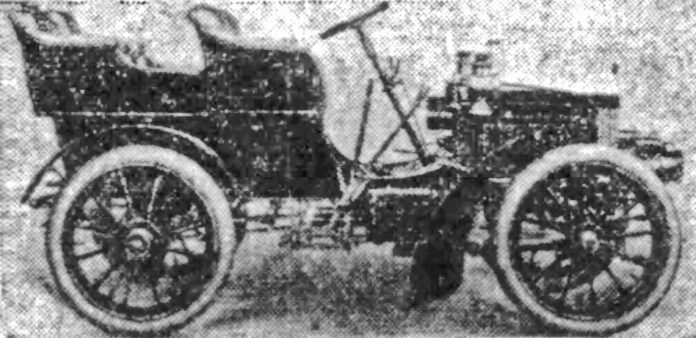In July, 1901, the summer guests of the Hotel Rowardennan enjoyed a glimpse of the future when a fine automobile pulled into its driveway. Joseph Kieley, a Klondike millionaire, and J. R. Burnham, who, according to the Sentinel, “has had much experience with autos,” made the run from Oakland in a little over eight hours, including an hour spent on the Big Tree Road between Santa Cruz and Ben Lomond.
Santa Cruzans were reluctant to embrace the new technology. “Generally speaking,” the Sentinel opined a year later, “this is not good territory for the use of the horseless wagon. Our streets and roads are too narrow, crooked, and uneven.”
In June of 1903, the residents of Boulder Creek became acquainted with the automobile, thanks to Charles Middleton, the brother of the local timber baron. The editor of the Mountain Echo was favorably impressed. “The Middletons and friends have since been having daily delightful outings with their riding machine and it has become quite a familiar figure on our streets and roads.”
On Thursday, the 26th, Mrs. Middleton decided to entertain her sister and another guest by taking a ride into Santa Cruz. With the chauffeur at the wheel, the ladies left Boulder Creek at seven o’clock in the morning. “They were very careful,” the Sentinel reported, “not to frighten teams and took every precaution. They had a boy go ahead on horseback to warn people with teams of the approach of the automobile and traveled at a slow pace.”
The expedition passed through Brookdale and Ben Lomond without incident. As they rounded a curve on the Felton road, however, their vehicle surprised a carriage carrying eight passengers. As the horses started to panic, a lady passenger jumped out and suffered some bruises. Fortunately, as the paper noted, “an experienced driver had hold of the ribbons,” and was able to calm his team.
Resuming the ride, the Middleton party rolled past the Toll House and through the woods to the Powder Works. They had almost reached the Santa Cruz city limits when a sprinkling wagon crossed their path. Its team reacted so violently that one of the horses fell and broke a leg.
The ladies arrived in Santa Cruz at 10:00 a.m. and told their tale at the local newspaper office. “They emphatically deny that the automobile collided with the sprinkling cart. They regret that the horse was injured, but do not see how they could have been any more careful than they were.”
Next month, Mrs. Middleton sang the Star Spangled Banner at Boulder Creek’s Fourth of July celebration. Her husband motored down from San Francisco in a friend’s car for the occasion. After the event, “it was decided by the owners, that the presence of the automobiles seemed to spoil the driving pleasure of so many of our visitors and others,” and the local roads returned to normal.
Reports of the ladies’ ‘June excursion’ fueled a campaign to ban automobiles from mountain roads. The Sentinel joined in enthusiastically. “One by one the various counties of the State are taking official action to exclude automobiles from mountain roads where their presence is a constant menace to the life and limbs of those who travel with horses – “Devil Wagon” is a proper name for the new mountain terror.”
In March, 1904, the county supervisors approved an ordinance setting speed limits – fifteen miles per hour on public highways and eight miles per hour on town streets. Additionally, automobiles were forbidden on Bear Creek Road and the road from Boulder Creek to Saratoga.
The critics were still not satisfied. “Last Fourth,” argued the Sentinel in July, 1904, “one hundred horse rigs passed up and down – between Santa Cruz and Big Tree Grove, carrying at least three hundred people, and three automobiles, conveying not more than twelve persons – nearly scared the life out of all the horses and people they met.”
Besieged by protestors, the Board of Supervisors amended their ordinance in August, adding the Big Tree Road between Santa Cruz and Boulder Creek to the prohibited list. “The danger from automobiles,” commented the Sentinel, “was recognized as a serious threat to the regular traffic and the amendment passed without a dissenting vote.”
Despite their success, the opponents of the new machines escalated their rhetoric. “As every auto race causes the death of one or more and the wounding of others, it has become as fatal as football – another sport which needs regulation.” There were those, however, who accepted change with a bit of humor. “Toot! Toot! Chuff! Chuff! Santa Claus is coming!” began an article on ‘Christmas Thoughts.’ “Of course, you will be straining your ears to catch the sound of tinkling sleigh bells, and right there is where you will make a grand mistake, for I imagine that Santa Claus will go his rounds this year in a mighty fine automobile.”
Frustrated by local authorities, the friends of the automobile enlisted the aid of the State Legislature. In April, 1905, the various county ordinances were repealed and replaced by a single set of rules. “The law provides that every auto shall be registered with the Secretary of State, and numbered, the number to be placed in large letters on every machine.” The act reads that along public highways no auto shall be operated at a greater speed ‘than is reasonable and proper,’ but it is further stated in the act that the speed shall not be greater than twenty miles an hour.”
Randall C. Brown is a local historian and is a member of the San Lorenzo Valley Board of Directors













